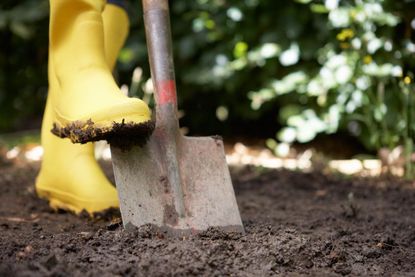Choosing Shovels For Gardens: What Shovel Do You Need For Gardening

Correctly choosing and using shovels in the garden is important. Choosing the right type of shovel for the job will help you work more effectively and avoid injuries. It will also provide better results for your garden.
Shovels and Their Uses
The sheer variety of shovels available in gardening and hardware stores can be confusing. Fortunately, most garden shovels fall into a few common categories, each intended to be used for specific garden tasks. If you’ve ever wondered “What shovel do you need for gardening?” this article will help answer your question. Before learning about the common types of garden shovels, it is helpful to know the parts of a shovel. From top to bottom, you will find the grip, then the handle, which varies in length, with longer handles better suited to digging deep holes and shorter handles better suited to precise tasks. Next is the collar, where the blade is fastened to the handle. At the bottom is the blade, typically made of metal or, in some cases, plastic. The flat portion at the top of the blade is called the step. The step allows you to use your foot and body weight to push the shovel into the soil, which is much easier than using just your arms! The blade and tip, also called the point, come in different shapes depending on the type of shovel. Now, let’s learn about common garden shovels and their uses.
Types of Garden Shovels
Round point shovel: This type of shovel has a strong blade with a point that helps it cut into the soil. It is useful for digging tasks. Square point shovel: This shovel is useful for lifting and moving materials. The square point can also be used to smooth soil during landscaping projects. Trenching or irrigation shovel: This shovel has a square, narrow blade that is good for making a deep hole without disturbing plants nearby. It can be used for transplanting or removing individual plants or, as the name suggests, for digging irrigation trenches. Drain spade: A cousin of the trenching shovel, the drain spade has a narrow blade with a rounded tip. It is great for digging narrow holes for transplanting flowers or shrubs and for digging or clearing out trenches. Scoop shovel: With wide, concave blades and flat tips, this family of shovels are made for lifting and moving materials. A snow shovel is an example. Other scoop shovels are made for shoveling grain or landscape materials like mulch. Scraper: These shovels have small blades and flat tips. You can use them to remove weeds or to neaten up the edge of the lawn as a substitute for an edger. Trowel: This is a small shovel for use with one hand. The small blade with a pointed tip makes the trowel useful for transplanting seedlings or small flowers, repotting, and other precise tasks. Garden shovel: This all-around tool has a rounded blade and a slightly pointed tip. It is useful for digging, transplanting, lifting, and all sorts of garden tasks.
Choosing Shovels for Gardens
Based on the above information, you now can choose the correct type of shovel for your task, which will make using shovels in the garden much easier.
- For digging, choose a round point shovel for larger tasks and a trowel for smaller, precision tasks.
- Use a trenching shovel or drain shovel for digging narrow holes for transplants, for removing plants with deep roots, or for digging trenches for irrigation.
- For lifting and moving material, choose a square point shovel or a scoop shovel depending on the type and weight of the material.
- For weed removal, choose a scraper or edger.
- For general gardening tasks, garden shovels and trowels are useful all-around tools.
Gardening tips, videos, info and more delivered right to your inbox!
Sign up for the Gardening Know How newsletter today and receive a free download of our most popular eBook "How to Grow Delicious Tomatoes."
Ilana Goldowitz Jimenez is a scientific and agricultural writer with a B.S. in Plant Sciences from Cornell University and a PhD in Chemical Biology and Infectious Disease from Harvard University.